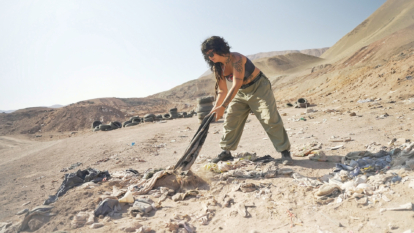Built from Scrap
Listen to the story.
All photos by Mateo Barrenengoa
On the coast of Tarapacá, Chile, those who live off the sea know how to recognize sustenance beneath the water. Even before the tide recedes and exposes the rocks, they know what’s hidden under the surface. Skillfully, they dive and get lost among its veins. And they never go hungry.
Just inland from Tarapacá, a young textile recycler, conscious-fashion artisan and environmental activist named Ángela Astudillo has developed a similar instinct. After years spent rummaging through the used-clothing graveyards scattered around Alto Hospicio, in the Atacama Desert, she has an eye for hidden treasure. Where I see heaps of rubble and discarded clothing, she finds the colors and textures of inspiring fabrics—materials for her work as a seamstress and textile recycler—rapidly filling two sacks she also finds there. She knows where to look.
I get carried away in the search, too, but the smoke from a burning pile of used clothing a few feet away wakes me from my reverie. In addition to emitting greenhouse gases, these textile microlandfills have a direct impact on the nearby community in Alto Hospicio. As the piles start to grow, they get burned, which releases toxic fumes. Residents endure unhealthy air and experience the bitter feeling of being ignored by decision-makers. For many, this area seems to be a place in permanent neglect. But it is also a place where new stories are being written—stories imbued with creativity, resilience, leadership and passion, which are capable of changing the bleak narrative.
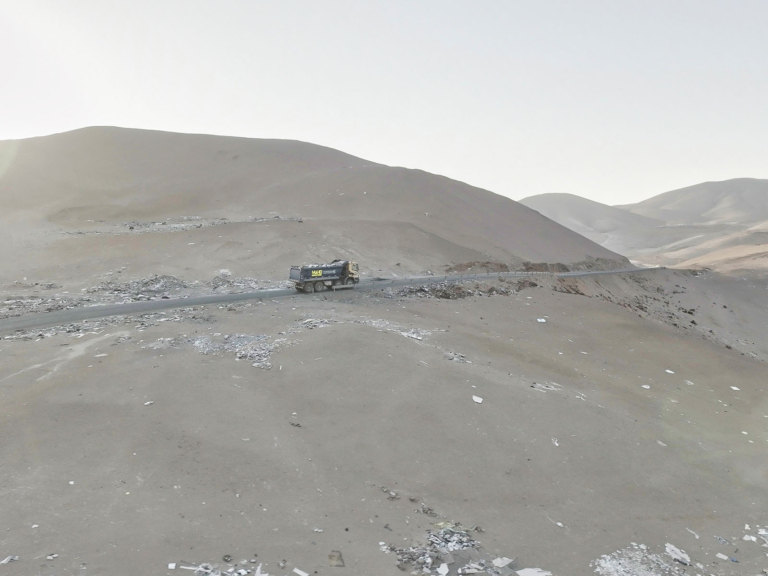
Loaded trucks come and go nonstop on the outskirts of Alto Hospicio. This is how used clothing—as well as all kinds of waste—arrives to the microlandfills surrounding the community.
It is morning on a vast and arid stretch of desert near El Boro, an outlying neighborhood of Alto Hospicio. We stand at the opening of an endless stream of waste. Its flow is continually replenished with used shoes, jackets, shirts, pants and other clothing. Despite the disheartening scenery, Angela seems absorbed by the landscape and shows excitement with each discovery.
The long journey of these discarded clothes begins in the first world—mainly the US, Europe and Asia—where they are cast off by their original owners or don’t make the cut for secondhand stores. Baled, shipped and custom-cleared, the used garments are counted by hundreds of thousands of tons. Iquique is their main door into Chile. The textile bales make landfall in Iquique’s tax-free zone, known as the “Zofri.”
What can’t or won’t be sold by secondhand merchants in the city makes its way to the dunes surrounding Alto Hospicio, 9 miles to the east. Here, the clothing is illegally scattered, buried or dispersed in microlandfills, then rapidly burned to hide its trace. Charred remains now cover vast expanses of the Atacama Desert.
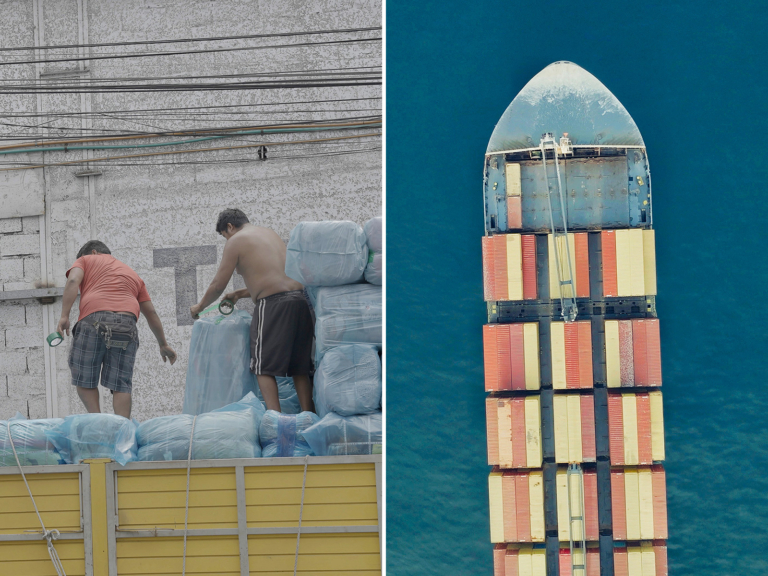
Over 160,000 tons of used clothing entered Chile between 2015 and 2022, and numbers keep growing. The clothes come from the northern hemisphere, only to end up discarded in underprivileged communities like El Boro. Iquique, Chile.
Back in 2021, the image of a gigantic used-clothing dump went viral and showed up in media outlets around the world. Alto Hospicio was portrayed as one of the main textile landfills on the planet and a blatant example of overproduction in the fashion industry.
That pile has mostly disappeared, but it remains in memory. In 2022, the mountain of clothing was burned by a fire of unknown origins. The fire lasted for two weeks, and the smoke was still present a month and a half later. It was far from the first time that pollution had threatened public health in Alto Hospicio, where residents had already endured over 20 years of contamination from industry waste, illegal landfills, water treatment plants and more. But rather than mark an end to the illegal clothing dumping problem, the fire merely escalated it.
“Since that landfill burned, the problem started to grow because there was no longer just one large landfill, but many microlandfills that began to appear in the surroundings of Alto Hospicio,” Ángela tells me. To date, Ángela’s environmental organization, Desierto Vestido, has identified around 160 of them. “In some, clothes remain for a long time, but mostly they are places where clothes are thrown away and burned quickly,” she says.
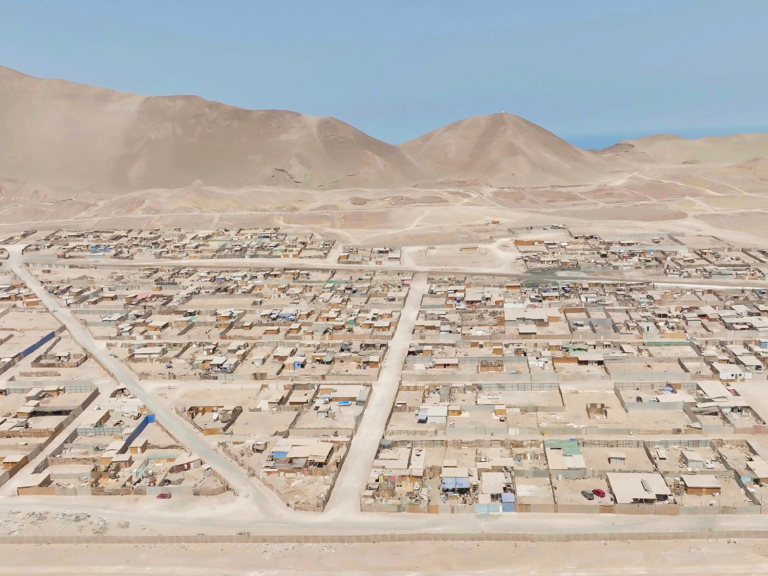
Land occupations have been a constant in Alto Hospicio’s history over the past few decades. El Paso de la Mula is one of the largest today, a true extension of the city built from lightweight material on the vast expanse of the desert.
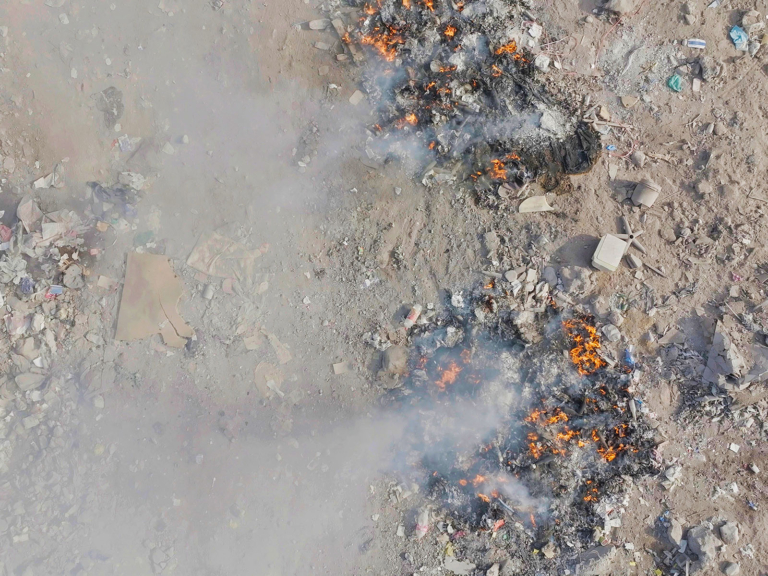
Fire is the weapon of choice when it comes to erasing the evidence of the illegal disposal of used clothes around Alto Hospicio, yet it carries toxic fumes to nearby communities like El Boro and other vulnerable areas.
Once a train station and later an agricultural settlement, Alto Hospicio’s rapid demographic growth began in the mid-80s, as land occupations multiplied and segregated communities organized in search of housing solutions. It soon became the fastest-growing community in the Tarapacá region. But along with the population surge came poverty, illegal immigration and crime—and the stigma that followed. Alto Hospicio got buried under the veil of a place in permanent neglect.
Today, the people who inhabit these lands feel that no matter what they do, illegal landfills multiply on a daily basis and the smoke from burning textiles and other debris gets into their homes and lungs. Every time someone knocks on their doors offering help or visibility to their problem, tags and brands hidden among the piles of clothes seem to be more important than the impact on people.
Media often portrays Alto Hospicio as an abandoned no man’s land and uses hurtful phrases like “the world’s landfill” or “the graveyard of the fast-fashion industry.” People like Ángela want to demonstrate that Alto Hospicio is capable of much more. In her quest for fabrics, and in the art she creates with them, she is realizing a vision for a more encouraging landscape than what media usually shows us.
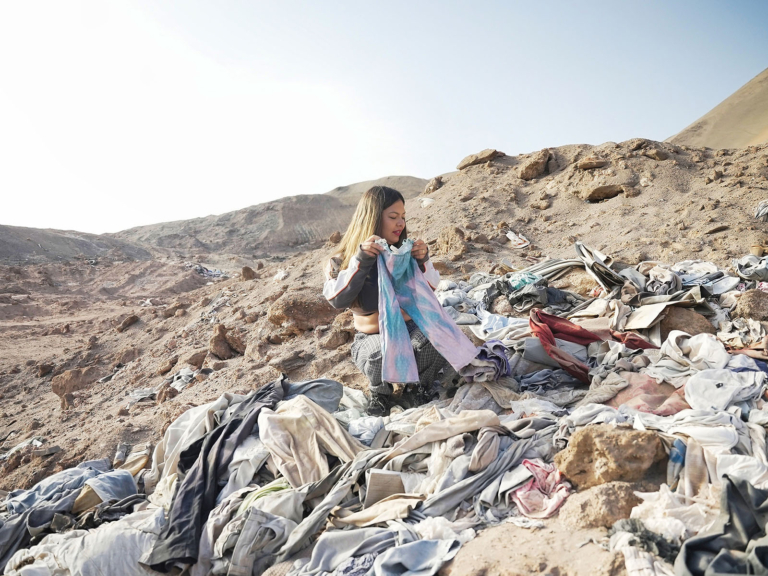
Ángela Astudillo handpicks garments from the landfill. Their colors and textures inspire her textile recycling work, which aims to draw attention to the impact of fast fashion on her community.
Every time she goes out into the landfill, she collects discarded clothes and envisions backpacks, bags and unique garments to craft in her workshop. As she sees it, creating new clothing from recycled textiles is activism. It raises awareness about the problem and fosters environmental education in the region. She wants to use textiles as an art to change perspectives on clothing consumption and waste management.
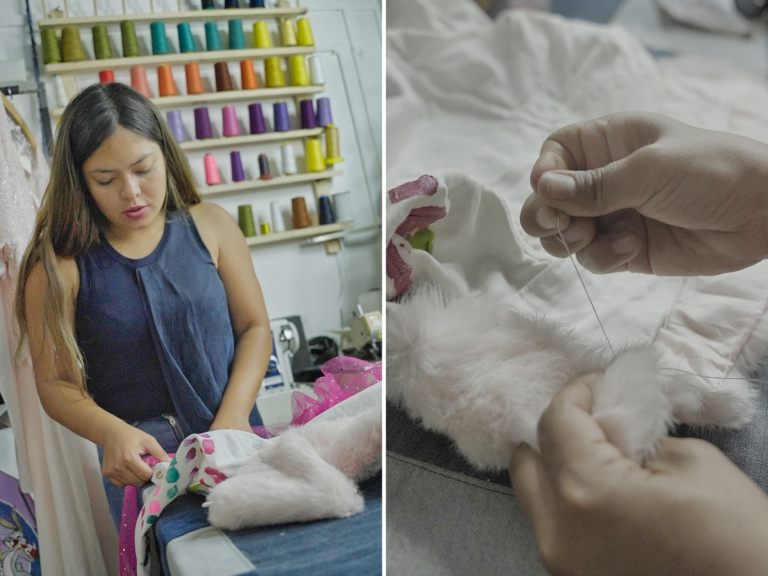
In her workshop, Ángela sews the final stitches on a new creation using garments recovered from the microlandfills. The inspiration for this piece came from her daughter, Dominique. Iquique, Chile.
“My dad worked with textiles and had a strong commitment to recycling, and I always saw that as something positive,” she says. “But when I realized that the pollution from used clothing had become such a huge problem, that no one was taking responsibility, and that there were no regulations to address this problem, I said to myself: We need to do something. So, I focused on it, and from my role as an artisan, I started creating with textiles. Now I’m 100 percent into this. I make clothes, accessories and environmental education from this area.”
From a problem, Ángela has found a calling: to reconnect Hospicians with the desert they often pass by, and to show people how to transform waste into something novel. She hopes to demonstrate how clothing can help tell a place’s story, just as ancient Andean textile artisans did for generations. And she hopes to prove that it’s possible to do this with whatever materials are available—even discarded ones. After all, when you scavenge what’s at hand, the possibilities are endless. In addition to her upcycling work, Ángela offers workshops for children and adults through organizations like Desierto Vestido, the Trade Association of Circular Economy, and Manito Verde. Thanks to her work, more and more neighbors and local textile artisans are opening up their imagination and seeing the opportunity in these materials.
As we walk north along a path of endless fabrics and debris, the air becomes unbreathable under the smoke of burned items. From behind a pile of clothes, two recyclers pass by and greet us. They are darkened by the sun, smoke and the grime of garbage.
A couple of days later, I visit the same microlandfill with Jenny González, who has spent over eight years serving as the president of the San Lorenzo Neighborhood Association in El Boro. Afterward, she can’t stop coughing. Her lungs can’t bear the plastic smell of the smoke embedded in our clothes. She’s too familiar with this scent, which flows with the Pampa’s wind from the landfills to the upper part of town.
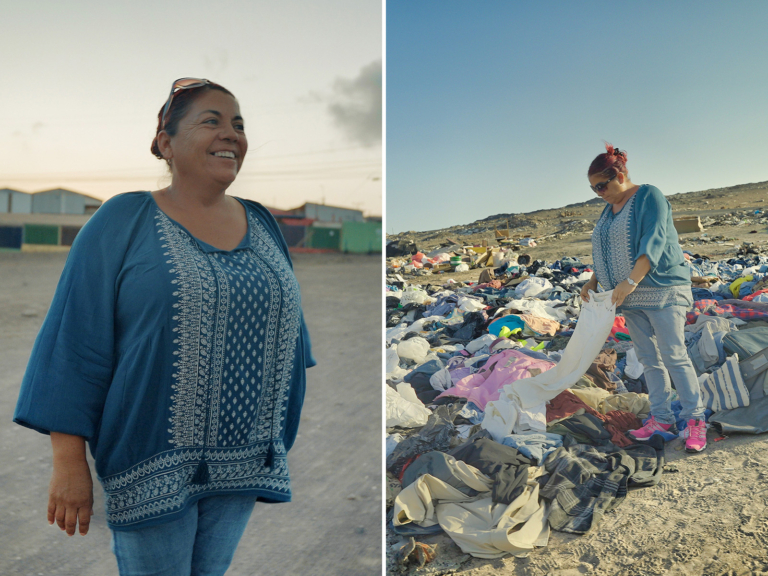
Left: Jenny González smiles every time she shares her dreams for El Boro. From a new family health center to a kids’ playground, everything is part of her vision for the place she has made her home.
Right: “What we need here is investment. We could have an established recycling center where neighbors could work,” Jenny says while we visit an improvised microlandfill just a few minutes from El Boro—which will surely be burned soon.
Jenny has lived here since El Boro was first inhabited. She worked in open-air markets and is now a community leader. More than just the used clothing, she’s fighting the imported, baled garbage that enters through the port without much oversight. She knows the problems of her community go far beyond the waste that surrounds it, and like Ángela, she daydreams about the future.
“We are a community of immense sacrifice,” she says. “We started as a land occupation, away from Alto Hospicio’s downtown. We’re surrounded by landfills, and we carry the social stigma of being treated as a sacrifice zone. There’s much to improve, but those of us here love this area.”
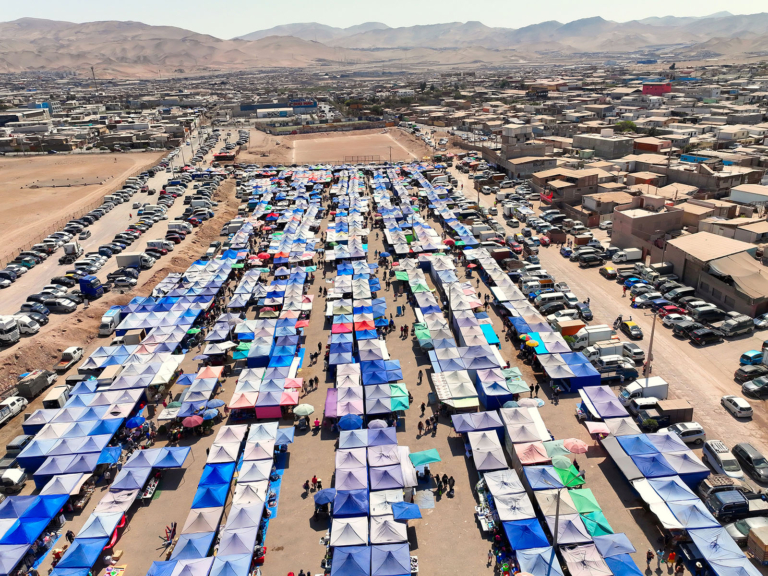
La Quebradilla, one of the largest open-air markets in Chile, exists thanks to the massive amount of used goods coming to this region. Hundreds of residents from Alto Hospicio find their livelihoods here by reselling what comes through the port, an essential part of the local economy.
Like many Hospicians, Jenny used to pick up secondhand bales from the tax-free zone in Iquique to resell at open-air markets. There’s a real economy around what comes through the port and ends up discarded on the area’s outskirts. The discarded clothes and waste that pollute the soil and coat nearby communities with toxic fumes simultaneously support hundreds, if not thousands, of people’s livelihoods. Jenny knows the impacts that have been placed on her community, and for her, the solution lies at the heart of the problem.
“We don’t have a waste management center, and we need one. What El Boro needs most is employment,” she states. “If we had a suitable facility where we could receive and sort clothes, that could be a source of income for people who currently have to work in deplorable conditions in the dumps.” If this idea were to come true, people like Ángela and other upcyclers wouldn’t have to venture into illegal landfills and risk their health between toxic fumes, pests and unsanitary waste.
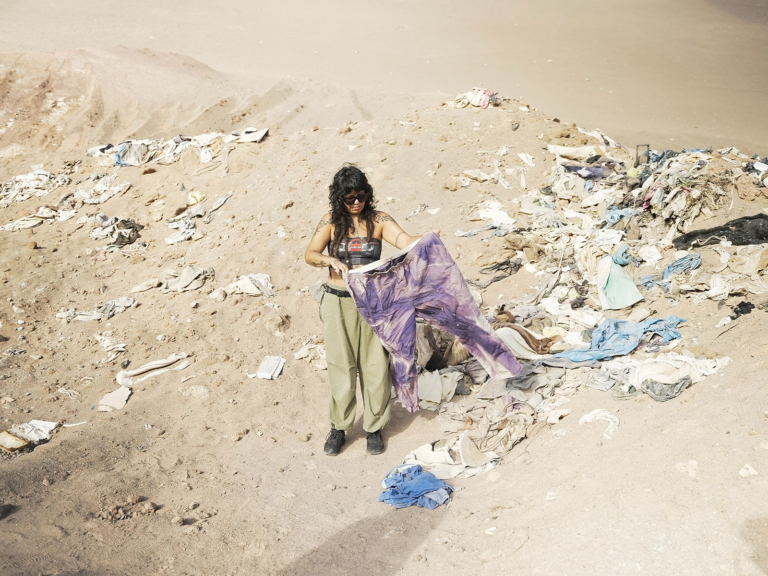
Forever chemicals? What about forever garments? Synthetic clothing preserves better under desert conditions, yet its slow decomposition also produces greenhouse gases. Clothing designer and activist Francisca Gajardo picks up a pair of pants to change their fate with needle and thread.
Meanwhile, for Francesca Hidalgo, part of the solution begins with education. Francesca teaches at Santa Laura Academy, a primary school located in front of the San Lorenzo Neighborhood Association. Most of her students live and grow up in the land occupations of El Boro and come from migrant families. She encourages them to see they have the power to change their world.
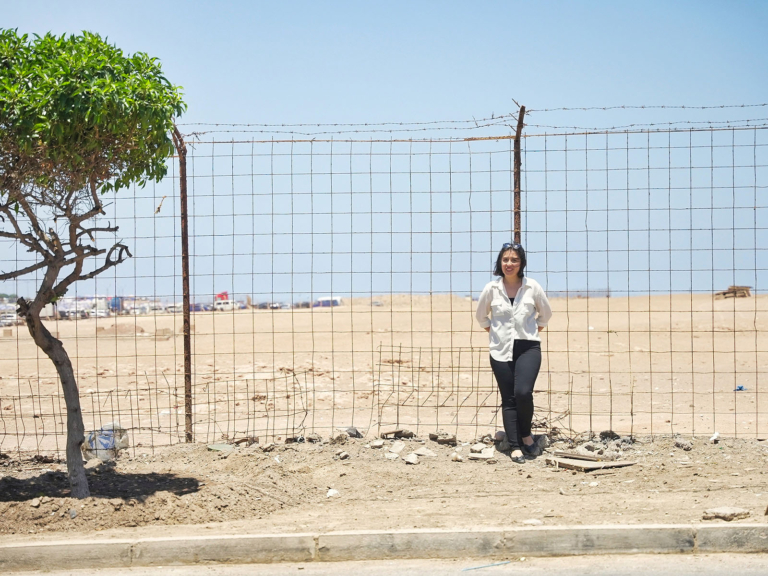
Through education, Francesca Hidalgo helps her students broaden their perspectives and see beyond the aridity that surrounds them. Most of the students live near El Boro and are impacted from living surrounded by the world’s discards.
“These clandestine landfills degrade the environment, yes, but they also affect children’s thinking because they normalize the illegal practice of dumping waste, as if these children deserve to live among waste because of their humble origins and the precariousness of their neighborhoods,” Francesca says.
Her students write op-eds and create infographics, posters and reports on reuse, recycling, desert care and sea care; and they learn about native flora and fauna. “Fostering reading is the tool that expands imagination and knowledge of the world,” she says. “Children create at all times, beyond what they can see and touch. They are constantly regenerating their relationships with the daily stuff.” To facilitate this, she organizes field trips, so they can experience and be nourished by other environments and stimulate their senses through play. The opportunity to experience different landscapes shows them that the desert is part of something bigger, too.
Both Ángela and Francesca are first-generation university students, and both see education as a tool to raise awareness, stimulate creativity and help more people see potential among waste. They want people to recognize their own resourcefulness and be able to create with their own hands—because from this skill, a trade can emerge. They want everyone to become agents of change for their community.
“Even the most abandoned place can be turned into something beautiful using what you have at hand,” Ángela says. We are in her Iquique workshop, which she shares with a group of entrepreneurial artisans who work in textile reuse and other trades. Her creative ease fills the room: She has upholstered the ceiling and walls with scraps of denim that she has found in the microlandfills. She stores tools, scissors, measuring tapes and thread in what used to be back pockets. Other supplies like buttons and snaps are also stored, reused or sold as part of her business. While we talk, she cuts fabric scraps that she later pins together to test shades and combinations. She dedicates much of her life to this craft while attending law school at night. She aspires to continue her activism through law.
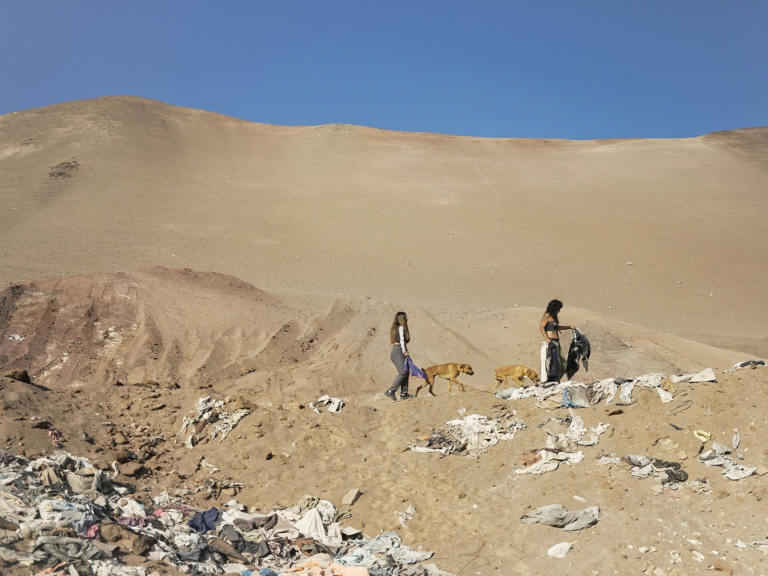
The microlandfills can appear to be small patches of waste amidst the vastness of the Atacama Desert. However, their impact runs deep in the territory and the community.
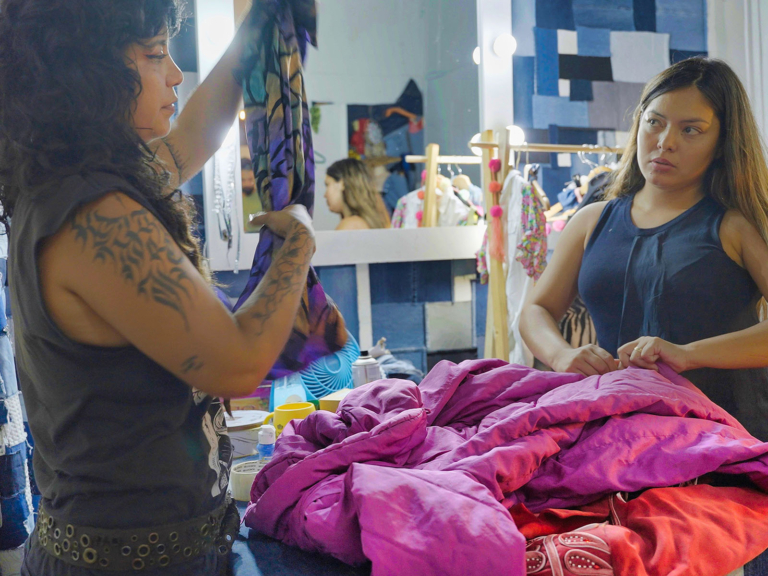
Francisca and Ángela let their imagination run wild after collecting garments from the microlandfill. Textile recycling is both art and activism, an exercise that values the creation of unique garments and draws attention to the impact on their community. Iquique, Chile.
Today, she is working with Francisca Gajardo, a clothing designer and upcycling activist with whom she has teamed up for a textile recycling contest. They pour their identity and stories into every stitch in much the same way that Andean textile artisans wove stories into traditional belts imprinted with suris, llamas and queñoas. When clothing transforms into a message, it transcends fashion.
Francisca is from Iquique and has traveled to different countries studying, teaching her craft and promoting a counterculture of clothing as environmental activism. “Brands should take responsibility, have their own traceability, implement digital passports, whatever it takes to be aware of the route their clothing follows. And then they should be able to recover it to work with it again,” she says. “But also, the industry has to shrink down. We are on the brink of extinction with the climate crisis, and there are brands that continue to release up to 52 collections per year. It’s stupid.”

Much of what comes out of the microlandfills are garments with little to almost no use, the failed results of donations intended to be a “sustainable” or responsible discard. It’s a reminder to think twice before buying something new, and perhaps think three or four times before letting go of a garment. Iquique, Chile.
A few weeks later, I help Ángela move to a new workshop. In a matter of days, she transports her presence. It seems like an apt metaphor for the world that she has created through clothes and activism: a world founded not on fabrics, nor seams, nor even the act of creation, but in the constant practice of venturing into the desert to search, find, collect and rescue. Without those journeys, Ángela’s work only exists halfway; its value lies in transformation.
I think about this during my last reporting trip, as I walk with Jenny looking for textile microlandfills in the outskirts of El Boro. We try to photograph a couple of owls sailing around us before they perch on a tree that projects from the rubble. Fresh air blows in the Pampa. It’s easy to lose yourself in the desert here. Unconsciously, I forget to lift my gaze from the ground, forget to take deep breaths. I lose myself in these extensive paths of ashes, watching a whirlwind dress itself with bags and fabric scraps that it lifts from the ground and spins in the air. I also forget that, as soon as we move farther away, all of this is still just a piece of land under the intense, clear blue sky, behind the endless hills that shine yellow at noon and fade into orange and purple once the sun goes down. The color of the desert gets through every window, no matter where you are.
Ángela, Jenny and Francesca have found a vision where the rest of the world sees waste. Where most of us see infinite aridity, they find a deep connection with the fertility of the territory. With their stories and their hands, they travel across the desert like whirlwinds, lifting more than simply dust: a new perspective, an invitation for others to become a part of it and the tools to transform it into reality.
